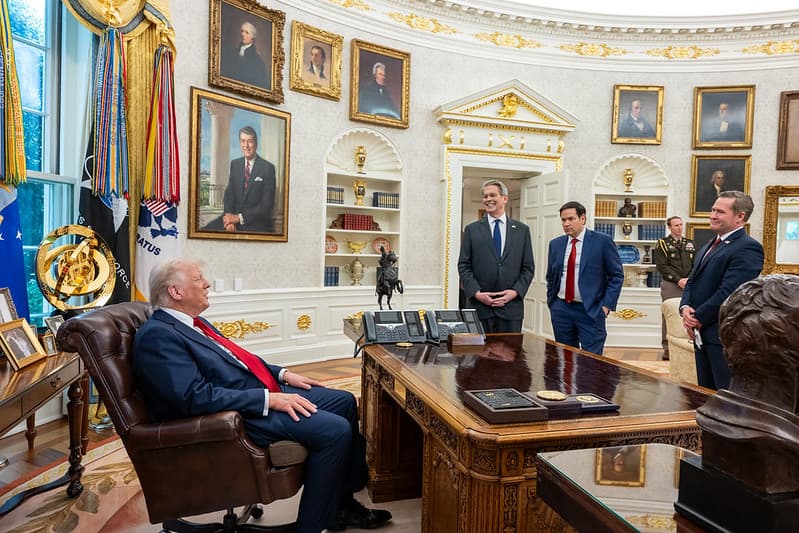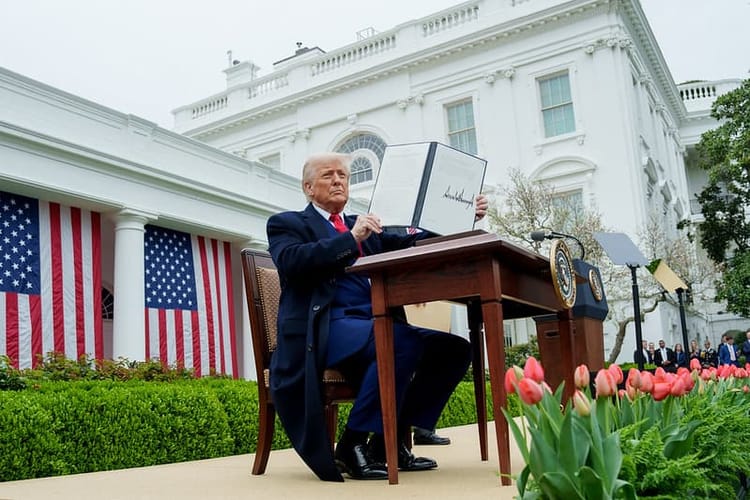President Trump: Reciprocal Tariffs Returning for Some; 50 Percent for EU Starting June 1st

Update: On May 25, after a phone call with European Commission President Ursula von der Leyen, President Trump announced that 50% tariffs on goods from the EU would be delayed until July 9th, the President's original deadline for reciprocal tariff negotiations. European leaders have pressured President von der Leyen to take a less confrontational approach to the tariffs.
As trade negotiations with some countries appear to be flagging, President Trump warned that he will follow through on threatened tariff increases for countries with whom the US has not reached a deal by the end of the current 90-day pause on reciprocal tariffs. The President also announced a 50% tariff on goods from the EU, starting June 1st.
Outlook
- Notwithstanding the July 9th deadline, the administration is unlikely to immediately hike tariffs on trading partners with whom productive negotiations are ongoing. This includes major trading partners such as the UK, India, Japan, and South Korea.
- Negotiations with China are subject to a separate 90-day tariff countdown (from May 12, 2025 to August 12, 2025). A durable resolution of US-China frictions that addresses root causes is highly unlikely in that timeframe. If no deal is reached, reciprocal duties on goods from China may resume at 34% or more.
- If the US goes ahead with 50% tariffs on EU goods, the EU is primed to retaliate, potentially leading to a tit-for-tat escalation. In the long run, incentives and constraints for both the US and EU strongly favor de-escalation and a deal, but this will likely require flexibility on both sides that is not currently present.
Other Impacts
- US stocks appear to be overreacting to the administration's temporary walk back on China tariffs. A sudden return to prohibitively high tariffs may again destabilize already weakened markets.
- Importers are likely once again to aggressively stockpile goods from China and elsewhere during the 90-day tariff reduction, potentially causing congestion at US ports. Payments on receivables may lag as businesses experience cash flow problems.
Analysis
During President Trump's recent trip to Qatar, he observed that "it's not possible to meet the number of people that want to see us.” According to the President:
Treasury Secretary Scott Bessent echoed this, saying on CNN's "State of the Union" that "President Trump has put them on notice that if you do not negotiate in good faith, you will ratchet back up to your April 2 level." On NBC News's "Meet the Press," he reiterated, "I would expect that everyone would come and negotiate in good faith."
Then, on Friday, May 23rd, President Trump announced on Truth Social that negotiations with the EU regarding the reciprocal tariffs "are going nowhere," and that a 50% tariff on goods from the EU would take effect starting on June 1st.
Shortly after this, Secretary Bessent observed in a Fox News interview that while many countries were negotiating in good faith, the EU was not, and that he hoped the looming tariff threat would "light a fire under the EU" to bring more substantive offers to the table. Commerce Secretary Howard Lutnick quipped that "some countries are impossible" to deal with, like the EU.
Later, in the Oval Office, President Trump told reporters, "I'm not looking for a deal. I mean, we’ve set the deal. It’s at 50 percent." He added that he would consider "a little bit of a delay" if EU companies committed to investing in US manufacturing.
Although President Trump's threats of increased tariffs are intended to maintain US leverage and accelerate the pace of negotiations, it would be a mistake to dismiss them as bluster. The President has demonstrated that he can and will follow through on deadlines and tariff threats, and is willing to pay a corresponding economic cost, up to a point.
What led President Trump to take these steps? Three factors appear to be driving the slowdown in negotiations: leverage-seeking, conflicting non-negotiables, and political optics.
Leverage-Seeking
Some commentators have argued that the longer negotiations take, the more pressure there will be on US markets and consumer prices, and the more flexible the US will be in its demands. Despite temporary tariff suspensions and upbeat media coverage on deals with the UK and China, US investor sentiment is still fragile. The world took note of US markets' rapid spiral after reciprocal duties were first imposed, followed closely by the Trump administration's temporary suspension of duties. US trading partners internalized that President Trump and his team are responsive to market instability, and some likely hope to capitalize on this in their negotiating strategies.
Can Trump’s Reciprocal Trade Negotiations Make America Great Again?
by Warren Maruyama, Meghan Anand, and William Alan Reinsch; Center for Strategic and International Studies
The Trump administration is also watching the clock. There is mounting pressure on the administration to demonstrate that its maximum-pressure approach is generating wins. In an interview with Politico, former USTR assistant counsel Patrick Childress observed that "it will be interesting to watch whether the level of detail in the announced agreements changes over time. It could be the case that we see less and less detail in these agreements as that 90-day clock starts to tick down and there’s political pressure to sign more and more of these agreements.”
Conflicting Non-Negotiables
There is still a gulf between US's asks and some countries' willingness to make concessions. For example, a consistent US pre-requisite for negotiations has been that trading partners be open to amending their laws and regulations, both to reduce tariff and non-tariff barriers to US exports and to reduce their own economic reliance on China. The general terms for the US-UK Economic Prosperity Deal featured this prominently and included pledges that the US and the UK would "[coordinate] to address non-market policies of third countries" (i.e., China), and cooperate on issues like inbound investment, export controls, and combatting third-country duty evasion.
However, EU officials dismissed US proposals as unrealistic lists of unilateral demands and declared that EU tax and regulatory autonomy is sacrosanct. European Commission trade official Matthias Jørgensen succinctly summarized this position: “EU legislation is not on the table.” Although Brussels has pushed back on China's economic policies in specific sectors like electric vehicles, it has historically been reluctant to challenge China holistically. Instead, it has sought to maximize benefits from maintaining economic ties with both China and the US simultaneously. Furthermore, the EU has not budged on the issue of its digital service taxes, which were specifically designed to target multinational US tech companies like Google and Amazon and continue to be a thorn in US-EU relations.
Nowhere are there more seemingly irreconcilable differences than in US's relationship with China itself. A durable resolution to US-China frictions would require China to agree to address the issues that caused the frictions in the first place: its policies and practices of massive subsidies, industrial overcapacity, forced technology transfer, and State-sanctioned IP theft; all in service of extracting manufacturing capacity from the developed world and bolstering China's export-led economic model.
These are the very policies that, from the perspective of Chinese President Xi and the Chinese Communist Party, led to China's economic rise and have cemented the CCP's legitimacy and leadership. For the Party, they are therefore non-negotiable. The CCP signaled this in its November 2024 readout of a conversation between Presidents Biden and President Xi, in which President Xi reportedly conveyed to President Biden China's Four Red Lines:
So, while a limited scope US-China deal is possible, a lasting resolution to US-China tensions and stabilization of the trading relationship is likely out of reach until China's leadership determines that a transition from an overcapacity and export-led economy to a consumption-based economy is in its, and the country's, best interests.
Political Optics
There is pressure on foreign politicians to not appear weak in the face of President Trump's bellicose style of dealmaking, which in some cases has constrained negotiators. Japan's ruling Liberal Democratic Party (LDP) lost its parliamentary majority in 2024, the first time in over a decade. Facing elections in July and behind in the polls, the LDP is sensitive to appearances of having capitulated to President Trump's demands. Japan's top priority has been to roll back automobile tariffs, but Japanese negotiators' enthusiasm waned as they realized only the reciprocal tariffs were on the table. A deal that did not include the withdrawal of automobile tariffs would likely be seen as a surrender back home and would fail to protect one of Japan's most economically critical industries. Although Japan was first in line for a deal when reciprocal tariffs were first announced, it has slowed its pace of negotiations until automobile and steel and aluminum tariffs are on the table.
The EU in particular has framed the administration's reciprocal tariffs as an attack on Europe itself - one that must be repelled forcefully. European Commission President Ursula von der Leyen, in response to President Trump's Liberation Day reciprocal tariff announcement, wrote,
German Foreign Minister Johann Wadephul argued for the importance of "defending Europe and the European market." European Commissioner for Trade and Economic Security Maroš Šefčovič argued on X that "EU-US trade is unmatched & must be guided by mutual respect, not threats," adding, "we stand ready to defend our interests."
European think tanks went further and characterized making a deal with the administration under duress of tariffs as "capitulating to blackmail." With respect to whether the US-UK negotiating framework could serve as a template, Swedish trade minister Benjamin Dousa said, "if the UK-US deal is what Europe gets then the US can expect countermeasures from our side... we will not be happy with that kind of deal." Unsurprisingly, the EU has repeatedly alluded to plans to retaliate since President Trump started announcing new tariffs, even before the reciprocal tariffs were announced on April 2nd.
As a result, US-EU talks have been sluggish, and the EU's settlement proposals, the most recent of which prompted President Trump to threaten tariffs at 50 percent, have been received in Washington as milquetoast and inadequate.





